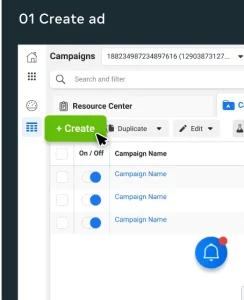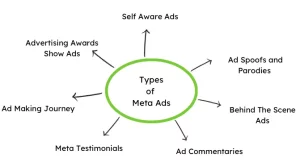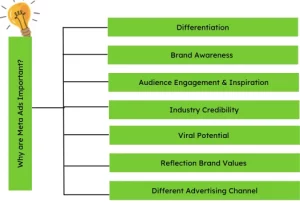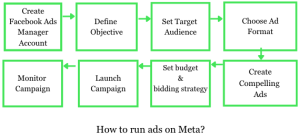Step by Step Guide to Create a Meta Ad in 2023
Reaching target audiences is always a challenge for the marketers. And when the data for digital marketing has risen exponentially over the years, meta ad have become saviour for all.
Meta ads are a type of digital advertising that deploys metadata to target specific audiences.
In this blog, you will get to read about meat ads and guide to creating one for 2023.
What are Meta Ads?
Meta ads, or meta advertising, refer to advertisements focused on promoting advertising rather than a specific product or service. It is about creating highly targeted ads that are relevant and engaging to the target audience.
These ads aim to raise awareness, generate interest, or provide insights about the advertising industry, creative techniques, or the benefits of advertising in general. Meta-ads often showcase the effectiveness, impact, or innovation of advertising campaigns, serving as self-referential promotional content within the advertising realm.

Meta-ads are based on meta-data, which is information that describes other data such as search history, browser history, and interests. The information is collected through web beacons, cookies, and other technologies.
Types of Meta Ads
These are the types of meta ads:

Self-Aware Ads:
These ads acknowledge that they are advertisements and playfully break the fourth wall, often incorporating humour or satire to connect with the audience.
Ad Spoofs/Parodies:
These ads mimic popular parody advertisements or advertising tropes, highlighting the conventions and techniques used in the industry while adding a humorous or ironic twist.
Behind-the-Scenes Ads:
These ads provide a glimpse into the making of an advertisement, showcasing the creative process, challenges faced, or the team behind the campaign. They offer transparency and insight into the advertising world.
Ad Commentaries:
These ads offer commentary or critique on advertising, raising awareness about advertising techniques, consumer behaviour, or societal impact. They may aim to spark discussions or challenge the status quo.
Meta Testimonials:
These ads feature fictional or real individuals praising the effectiveness or impact of advertisements. They cleverly blur the line between advertising and reality, adding an element of intrigue and self-awareness.
Ad-Making Journey:
These ads document the journey of creating an advertisement, from concept development to execution, showcasing the effort, creativity, and strategy involved. They provide a behind-the-scenes look at the advertising process.
Advertising Awards Show Ads:
These ads are created explicitly for advertising awards shows, celebrating the industry’s achievements and showcasing exceptional campaigns, often using a meta approach to highlight the talent and innovation within the advertising community.
Read: Complete guide to advertising on Amazon
Why are Meta Ads important for Digital Marketing?
Meta ads brings target audience close for the businesses:

- Differentiation: Meta ads allow brands to stand out by promoting the advertising concept and showcasing creativity and innovation within the industry.
- Brand Awareness: Meta ads can generate buzz and increase brand visibility by capturing attention with self-referential and thought-provoking content.
- Audience Engagement: Meta ads have the potential to captivate audiences, provoke conversations, and encourage users to share and engage with the content.
- Industry Credibility: Utilising meta ads demonstrates a brand’s understanding and involvement in advertising, enhancing credibility and positioning as a thought leader.
- Creative Inspiration: Meta ads can inspire marketers and advertisers by showcasing unique storytelling techniques, innovative concepts, and effective communication strategies.
- Viral Potential: Self-referential and clever meta ads can go viral, gain widespread attention, and extend the reach of a brand’s message.
- Reflection of Brand Values: Meta ads allow brands to align themselves with values such as creativity, innovation, and the power of advertising, reinforcing their brand identity.
- Different Advertising Channels: Meta ads can be adapted to various digital marketing channels, including social media, video platforms, websites, and print media, maximising their reach and impact.
Guide for Meta-Ads 2023
These are the things you must keep in mind when thinking of Meta-Ads:
Understanding Meta Ads:
- Defining meta ads: Exploring the concept and purpose of meta advertising.
- Benefits and objectives: Uncover the advantages of using meta ads and how they contribute to your overall marketing goals.
- Types of meta ads: Discover various formats and approaches to meta advertising, from humorous and self-aware campaigns to thought-provoking and innovative executions.
Crafting Effective Meta Ads:
- Audience analysis: Identify your target audience and understand their preferences to create relevant and engaging meta-ads.
- Creative storytelling: Learn techniques to craft compelling narratives that highlight the value and impact of advertising itself.
- Visual and textual elements: Harness the power of imagery, typography, and copywriting to effectively convey the essence of meta ads.
- Incorporating humour and wit: Explore the role of humour in meta ads and how it can resonate with viewers while delivering your message.
Meta Ads in Different Channels:
- Television and video platforms: Discover strategies to create attention-grabbing meta ads for TV commercials, online videos, and streaming media.
- Print and outdoor advertising: Explore innovative ways to utilise print media and outdoor spaces to showcase meta ads and generate buzz.
- Digital and social media: Unleash the potential of meta ads on websites, social media platforms, and digital advertising networks, leveraging their interactive and shareable nature.
Measuring Success and ROI:
- Key performance indicators (KPIs): Define relevant metrics to measure the effectiveness of your meta-ad campaigns, such as brand awareness, engagement, and audience response.
- Tracking and analytics: Implement tools and methodologies to track the performance of your meta ads and gather actionable insights for future optimization.
- Return on investment (ROI): Evaluate your meta-ad campaigns’ financial impact and value, understanding their contribution to overall marketing goals.
How to Run Ads on Meta?
If you are referring to running ads on the Meta (Facebook) platform, you can follow these general steps:

- Create a Facebook Ads Manager account: Set up an account on Facebook Ads Manager if needed.
- Define your advertising objective: Determine the goal of your ad campaign, such as increasing brand awareness, driving website traffic, or generating leads.
- Target your audience: Use Facebook’s targeting options to select the specific demographics, interests, and behaviours of the audience you want to reach with your ads.
- Choose your ad format: Select the type that aligns with your campaign goals, such as image ads, video ads, carousel ads, or lead generation ads.
- Create compelling ad content: Craft engaging and persuasive ad copy, choose eye-catching visuals or videos and include a clear call-to-action that encourages users to take the desired action.
- Set your budget and bidding strategy: Decide on your daily or lifetime budget for the campaign and choose how you want to bid for your ads, whether it’s the cost per click (CPC), cost per thousand impressions (CPM), or other bidding options available.
- Launch and monitor your campaign: Review your ad settings, schedule the start and end dates, and launch your ads. Monitor their performance regularly through Facebook Ads Manager, tracking metrics such as impressions, clicks, click-through rate (CTR), and conversions.
Conclusion
Meta ads serve as a vital resource for digital marketers aiming to efficiently connect with their desired audience. By leveraging metadata, advertisers can craft particular ads that resonate and captivate their target demographic.
This targeted approach enhances engagement, conversion, and overall return on investment (ROI). We can help you to create and execute Meta Ads. Write to us at hello[at]noboruworld.com
FAQ
What is a Meta Ad?
A Meta Ad is an advertisement that appears within the meta tags of a web page’s HTML code. It is typically used for search engine optimization (SEO) to provide concise and relevant information about the page’s content, enticing users to click on the ad and visit the website.
How are Meta Ads different from traditional ads?
Unlike traditional ads displayed visually on websites or search engine result pages, Meta Ads are not directly visible to users. Instead, they are embedded in the HTML code of a webpage and are primarily intended for search engines to understand the content and provide relevant information in search results.
What are the benefits of using Meta Ads?
Meta Ads can improve a website’s search engine visibility and attract more targeted organic traffic. By optimising the meta tags with relevant keywords and compelling descriptions, websites have a better chance of appearing in relevant search results and capturing users’ attention, ultimately leading to increased website visits and potential consumers.



